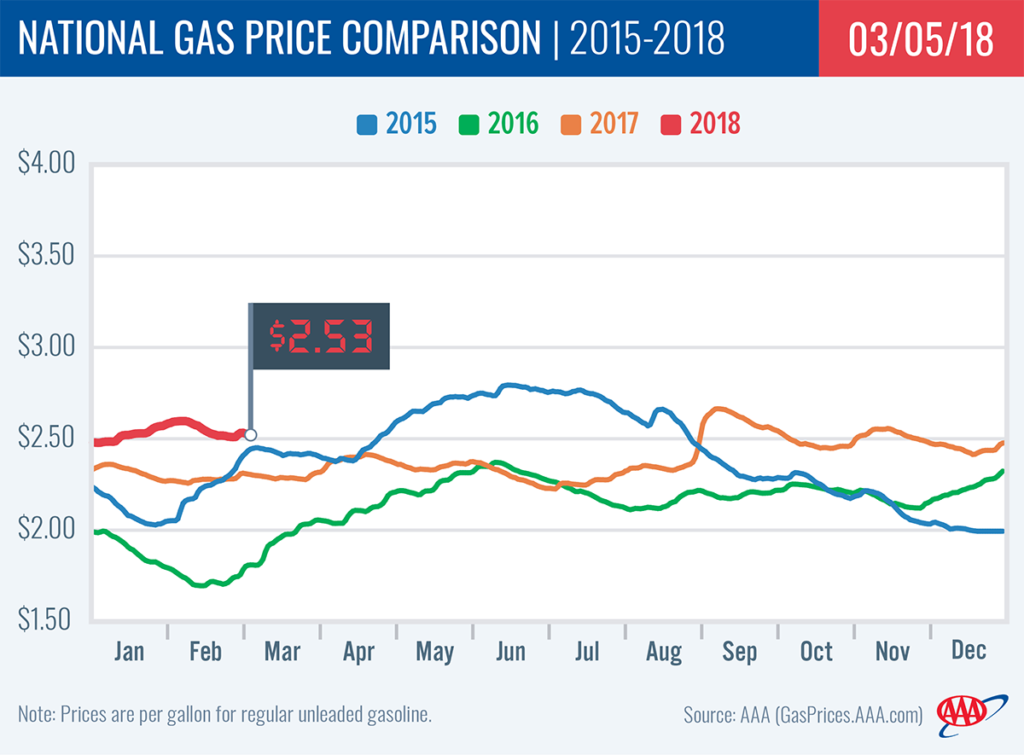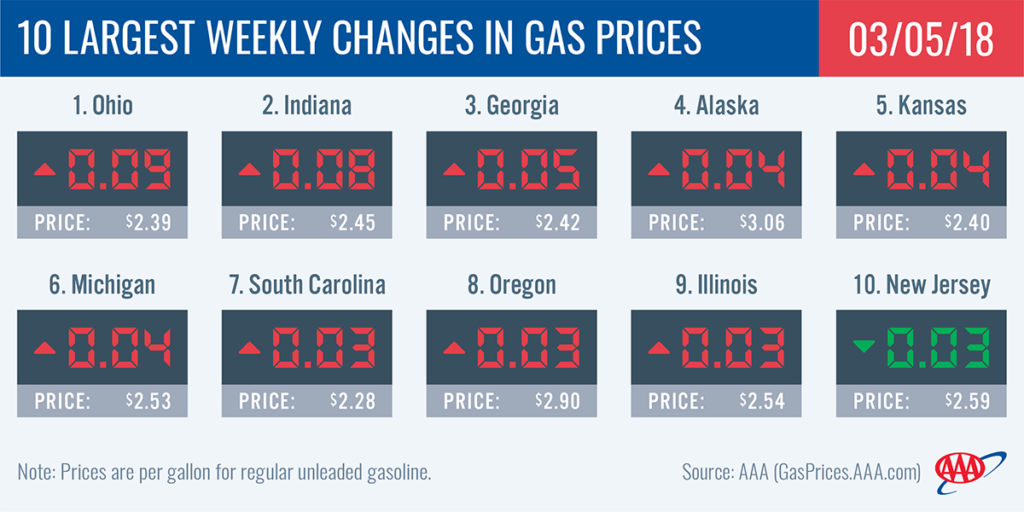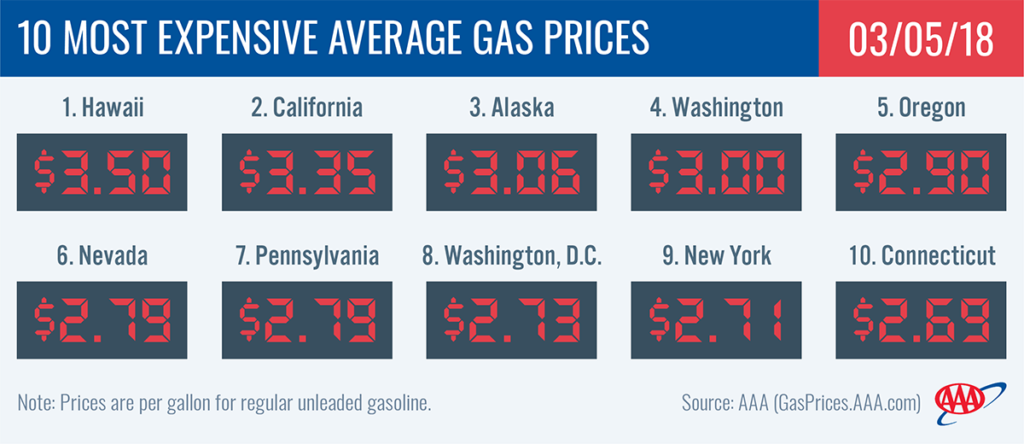Following three weeks of pump price declines, half of the country is seeing gas prices climb as much as 9 cents on the week. At $2.53, the national gas prices average is one cent more than last Monday with 25 states seeing gas prices increases. That being said, today, 63% of motorists in the United States can fill up for $2.50/gallon or less.
“2018 has seen fluctuating crude oil prices, strong gasoline demand and new U.S. oil production records creating a volatile gas price market from month to month for consumers,” said Jeanette Casselano. “Typically, March brings more expensive pricing as days get longer, weather gets warmer and refinery’s gear up to switchover to pricier summer blends.”
Today, gas prices are 8 cents cheaper from last month. However, they are still 22 cents more expensive than this time last year.
Quick Stats
- The largest weekly changes are: Ohio (+9 cents), Indiana (+8 cents), Georgia (+5 cents), Alaska (+4 cents), Kansas (+4 cents), Michigan (+4 cents), South Carolina (+3 cents), Oregon (+3 cents), Illinois (+3 cents) and New Jersey (-3 cents).
- The nation’s top ten most expensive markets are: Hawaii ($3.50), California ($3.35), Alaska ($3.06), Washington ($3.00), Oregon ($2.90), Nevada ($2.79), Pennsylvania ($2.79), Washington, DC ($2.73), New York ($2.71) and Connecticut ($2.69).
West Coast
Drivers in six states in the West Coast region are paying the highest pump prices in the country: Hawaii ($3.50), California ($3.35), Alaska ($3.06), Washington ($3.00), Oregon ($2.90) and Nevada ($2.79). On the week, all prices in these states are up. Alaska (+4 cents) and Oregon (+3 cents) saw the largest jumps, while Hawaii and Washington each increased by two cents. Both California and Nevada inched up by a penny.
According to the Energy Information Administration (EIA), gasoline inventories saw a draw down for the third consecutive week; decreasing by 1 million bbl. Still, inventories now sit at 33.2 million bbl, which is nearly 3 million bbl higher than they were at this time last year. Planned maintenance at refineries in the region has helped to lower stocks.
Great Lakes and Central
Gas prices have increased for the majority of states in the region on the week. With a 9-cent jump, Ohio is seeing the largest increase in the country and region followed by Indiana (+8 cents) and Kansas (+4 cents). Only four of the 13 states in the region saw prices decrease: Iowa (-2 cents), Kentucky (-1 cent), Minnesota (-1 cent) and North Dakota (-1 cent).
Compared to last month, all motorists in the Great Lakes and Central states are seeing a cost savings at the pump. These states are seeing the largest drops: Indiana (-15 cents), Kentucky (-15 cents), Iowa (-14 cents), Michigan (-14 cents), Nebraska (-12 cents), Wisconsin (-8 cents), Illinois (-8 cents) and Minnesota (-7 cents).
On the week, gasoline inventories built by 1.7 million bbl to register at 60 million bbl. This is the largest inventory total the Great Lakes and Central region has seen this year and on par with levels this time last year, according to the EIA.
South and Southeast
Gas prices are more expensive on the week for every state in the region. Georgia (+5 cents), South Carolina (+3 cents) and Texas (+3 cents) saw the largest increases in the region and also land on the top 10 states with the biggest changes this week.
Compared to the first week of March 2017, gas prices are more expensive in the South and Southeast region. At 11 cents more, New Mexico is seeing the smallest year-over-year change while Florida (+25 cents) tops the region for the largest yearly price change.
With a 1.8 million bbl build, gasoline inventories in the South and Southeast region total at 85.3 million bbl. This is a new record for 2018 and 3.6 million bbl ahead of inventory levels this time last year.
Mid-Atlantic and Northeast
Gas prices increased in only two states in the Mid-Atlantic and Northeast region on the week: North Carolina (+2 cents) and Tennessee (+1 cent). Gas prices decreased 1 to 3 cents in all other states with New Jersey seeing the largest drop.
Six states land on the 10 top list for largest year-over-year gas price change, paying as much as 30-cents more for a gallon or regular: Massachusetts (+31 cents), Rhode Island (+31 cents), Vermont (+30 cents), New Jersey (+30 cents), Connecticut (+29 cents) and New Hampshire (+28 cents). At 19 cents more, North Carolina is seeing the smallest year-over-year change at the pump in the region.
Gasoline inventories remain above the 65 million bbl mark despite a second week of declines. The region is facing a 10 million bbl deficit compared to this week last year, according to EIA data.
Rockies
On the week, all states are paying less at the pump: Utah (-3 cents), Wyoming (-2 cent), Colorado (-1 cents), Idaho (-1 cent) and Montana (-1 cent). With a 1-cent increase, Montana ($2.59) is selling the most expensive gas in the region followed by Idaho ($2.56). At $2.41, Colorado carries the cheapest gas of all five states.
Inventories took a slight dip, but continue to measure above the 8 million bbl mark. Total inventories are sit about 380,000 bbl below EIA reports from this week last year.
Oil market dynamics
After losses throughout last week, WTI increased 26 cents to settle at $61.25 at the close of Friday’s formal trading session on the NYMEX, The losses earlier in the week came after EIA’s petroleum report revealed that crude oil inventories grew by 3 million bbl last week. Moreover, crude runs at refineries inched up to 15.9 million b/d, marking slower than expected growth. At the same time, domestic crude production continues to boom at 10.3 million b/d, which could cause inventories to continue to increase. If they do, oil prices may take a further hit when EIA’s weekly petroleum report week is released on Wednesday. Additionally, the U.S. gained an active oil rig last week, bringing the current total to 800.
Motorists can find current gas prices along their route with the free AAA Mobile app for iPhone, iPad and Android. The app can also be used to map a route, find discounts, book a hotel and access AAA roadside assistance. Learn more at AAA.com/mobile.



